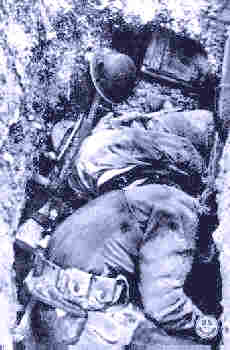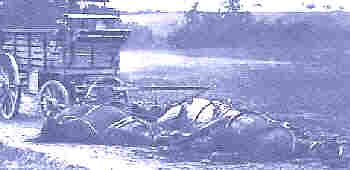On the appointed day, Dharmaraja sits on a newly made chariot which is drawn by sixteen white horses. Bheema is the charioteer, Arjuna holds up the white umbrella and are fanned by Nakula and Sahadeva. Yuyutsu, Satyaki and Krishna follow in different chariots. Kunti, Draupadi, Subhadra and other women, accompanied by Vidura join. Right in front are Dhritharashtra and Gandhari in a palanquin. Well decorated elephants and horses, foot soldiers, balladeers and minstrels follow in the rear.
The city is decorated with flags, the streets are clean and the aroma of incense wafts in the air. Holy water is kept at different places to be used at the consecration ceremony of the king. People throng the streets and greet Pandavas and Draupadi as they enter. Conches are sounded, drums are beat and the vedic chants are heard as pandavas enter the palace.
Yudhisthira sits on golden throne facing east. Krishna and Satyaki are in front and Bheema and Arjuna on the sides. Rest are seated suitably. Leading citizens approach and offer tribute. Then the priests begin the consecration ceremony.in which Krishna, Dhritharashtra and many prominent citizens participate. Brahmins bless the king and receive fees due to them. Thus Dharmaraja becomes the king of a large kingdom and the people are happy.
Bheema is declared as the Yuvaraja, and Vidura as the minister . Then Sanjaya is appointed in-charge of treasury, Nakula as chief of their forces and Arjuna to deal with other countries. Sahadeva becomes the guard of Yudhisthira. It is the special responsibility of Vidura, Sanjaya and Yuyutsu to take special care of Dhritharashtra. He also announce that whoever wants to please him, would do so by treating Dhritharashtra like a devata and taking care of his wishes. 'Even if I have killed my relatives, I live only for him.'
While the description of the ceremony installing Dharmaraja as the king seems routine. The fact that the city has gone through a traumatic war very recently tells us that humans recover and get on with life quickly. It is obvious that while the royalty were at the river front, the massive operation of dealing with the dead, the men, horses and elephants, was being done. Who were these people, and how did they accomplish this huge task? With millions reported dead in the war of 18 days, it would have been mega task indeed! Did they identify the dead and were the family allowed to take the dead bodies? Or was it a mass burial? One can only guess! I do not know if the full text of Mahabharata deals with this aspect of the war. May be not!
As the war was mostly fought in the day, we can assume that in the evening, the wounded and the dead were carried away and the dead were probably cremated with proper rituals. We also know towards the end of the war, whichever group performing this task, were overwhelmed with the number of dead. We read that the dying Duryodhana was lying on the ground and was chasing away wild animals with great difficulty. Ashwatthama and the others who came to see him, did not try to move him or make serious attempts to alleviate his misery. They were only bent on revenge. It is very apparent that those were strange times or attitudes were different. Even the resolve of the soldiers to die in a war and assure themselves of a place in heaven made sense. Being seriously wounded and incapacitated was not really an option for these warriors.
I was also worried about the dead bodies lying unattended and about serious risks of an epidemic.
There is some reassurance in this ICRC article linked above:
'Surprisingly, the answer is " Don’t rush! " Contrary to popular belief, dead bodies are a negligible health hazard. After a disaster, the top priority is to look after the living. Rushing to bury the dead diverts resources away from rescue efforts and can make it impossible to identify bodies later.
Having said which, there is the
question of dignity for the dead, and the sight and smell of dead bodies
can be distressing. We therefore recommend moving all unidentified dead
bodies to specially designated body collection areas once resources
become available.'
Here is another article about burial of the dead in world war I. WWI being the closest to the great Mahabharata war. It was also a conventional war with lots of man-to-man combats!
AMERICAN EXPEDITIONARY FORCES
France.October 21, 1918
From: Chief Surgeon, First Army Corps, American E.F.
To: Chief Surgeon, S.O.S., American E.F.
Subject: Systematic Method for Burial of Dead
1. Attention is invited to the necessity for establishing for the entire A.E.F. a system for burial of dead during open operations.

Dead Doughboy of the 38th Infantry
During active open operations burial of the dead becomes a sanitary matter of the greatest importance. During the Chateau-Thierry campaign many bodies of men and animals lay on the battlefield for days after their death. During the warm weather prevailing then, they soon decomposed and formed most unsightly and insanitary objects. The stench was terrific but the worst feature was that of fly breeding. The bodies of both men and horses soon become a mass of maggots and flies bred by millions - the surrounding country was infested with them. The result was a widespread outbreak of enteric disease that fortunately carried with it no mortality. Men were usually sick only a few days and were not seriously ill. A few however showed blood and mucus in the stools and were real dysentary. Bacteriologically, Flexner and Shiga bacilli were isolated as well as paratyphoid. It is therefore apparent that a serious outbreak of real dysentary was narrowly averted. It is not certain that flies were responsible for this outbreak but the presumptive evidence is strong.
2. It at once became evident that some systematic method of solving this problem must be adopted
The writer felt very strongly that combatant troops should not be called upon for this work for several reasons:
(a) From a sanitary viewpoint, burials should be accomplished promptly. Fighting troops cannot be removed from the line for this purpose.
(b) After an engagement, combatant troops are exhausted and should not be called upon to perform manual labor, at least until they have been thoroughly rested.
(c) The effect upon the morale of combatant troops of being compelled to bury their own dead is very bad. During conditions such as they were at Chateau-Thierry when the bodies soon became black, swollen, discolored remnants of humanity, literarily covered with maggots, the effect is of course tremendously bad.
(d) If left to combat troops, each division will have its own method or no method at all and the results are bound to be unsatisfactory
3. Upon the recommendation of the Corps Surgeon, the following plan was adopted by the 1st Army Corps.
One company of Pioneer Infantry (Corps Troops) is assigned to each division and is placed under the control of the Division Sanitary Inspector. They are to be used for no other purpose than burial of the dead - men and animals. They follow up the advancing combatant troops as closely as possible and bury the dead as they find them. They are supplied with picks and shovels and rationed with the division.
Bodies of men are collected whenever possible into groups and buried together in selected spots.

Dead Horses
Animals are buried wherever it is most convenient - as near where they fall as may be in order to avoid dragging them any distance.
Chaplains of the division are charged with all other details except the actual burying. They collect personal belongings, hold whatever services are possible and in conjunction with the Graves Registration Service, assure proper identification.
The plan has worked admirably and the present battlefield is in great contrast in this respect to those preceding. No dead bodies can be found until one reaches the very advanced areas where the Pioneer troops have not yet arrived.
The labor in burying a number of dead horses is enormous, and with heavy casualties of both men and animals, one company to a division is not sufficient.
4. This detail is also utilized in filling old latrines and doing other necessary work as they pass along the area.
5. It is believed that probably better administration could be secured by placing all the companies of Pioneers that are available for this work under the control of the Corps Sanitary Inspector. He can then distribute them and change them as circumstances require.
6. It is repeated that this is a most important sanitary problem that has been very satisfactorily solved in this Corps by the above plan.

Burial Detail
J.W. GRISSINGER Colonel, Medical Corps, U.S.A.
1 comment:
The spirits have gone to heaven since they died in combat.
The lack of attention to the problem is probably symbolic of the Indian belief that the visible body is a temporary shelter for the Átman"
R
Post a Comment